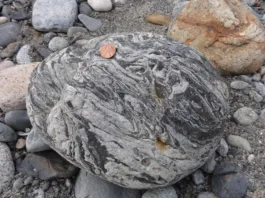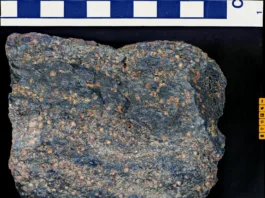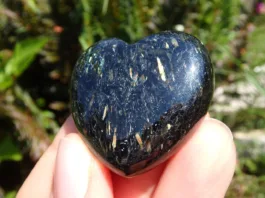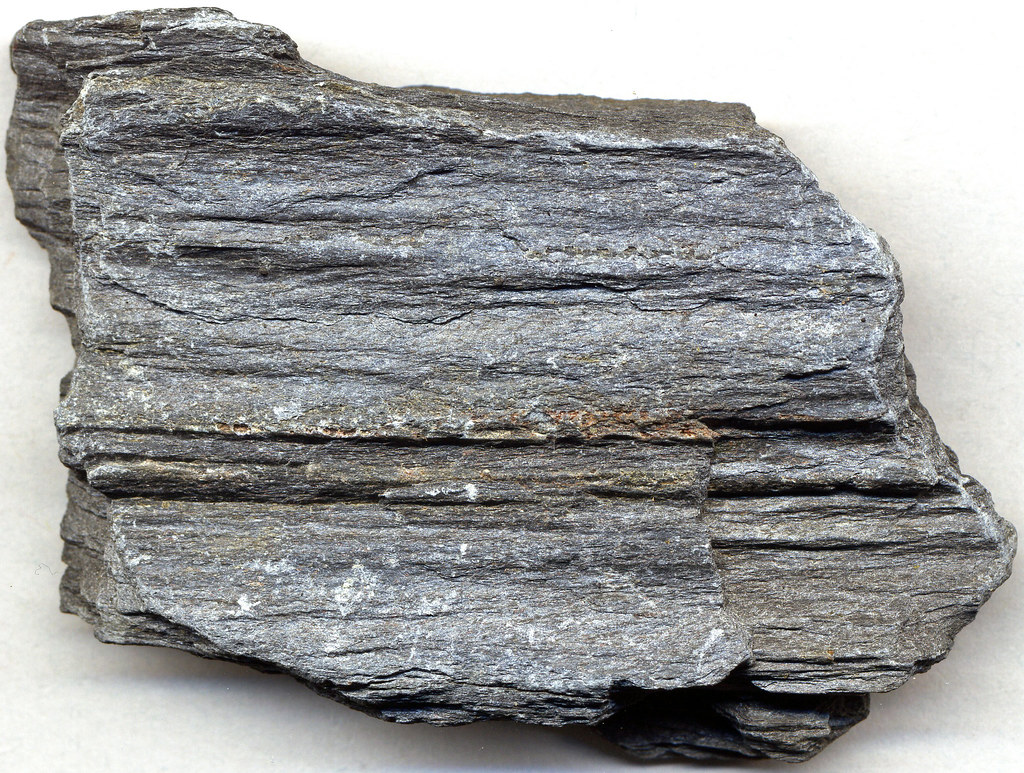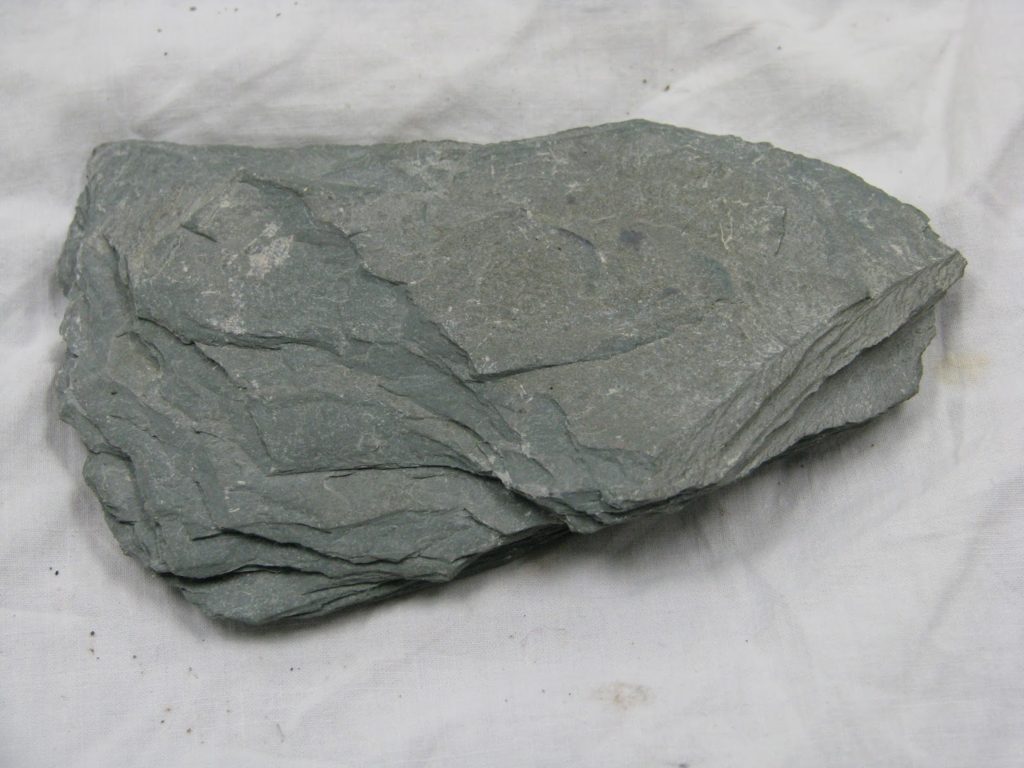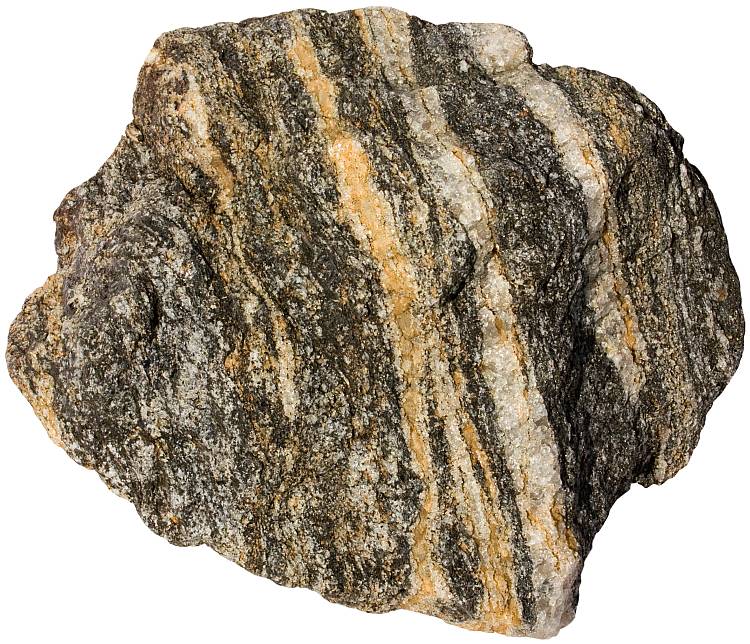Greenschist is a metamorphic rock that forms under low-grade metamorphic conditions. It is named for its green color, which is primarily due to the presence of minerals such as chlorite, epidote, and actinolite. The green coloration distinguishes greenschist from other metamorphic rocks and reflects the mineral assemblage and metamorphic conditions under which it forms.

Characteristics of Greenschist:
- Mineral Composition: Greenschist typically contains minerals such as chlorite, epidote, actinolite, albite, and sometimes garnet. These minerals undergo metamorphic changes from the original parent rocks.
- Texture: The texture of greenschist can vary, but it often exhibits a foliated or layered appearance due to the alignment of platy minerals like chlorite.
- Color: As the name suggests, greenschist is characterized by its green color, which is a result of the abundance of green minerals like chlorite. However, the exact shade of green can vary depending on the specific mineral composition.
- Formation at Low-Grade Metamorphism: Greenschist forms under relatively low-grade metamorphic conditions, typically at temperatures between 300 to 450 degrees Celsius and pressures of about 1 to 4 kilobars. These conditions are higher than those for slate and phyllite but lower than those for amphibolite and higher-grade metamorphic rocks.
- Metamorphic Grade: Greenschist is considered a low- to intermediate-grade metamorphic rock, indicating the moderate temperature and pressure conditions it undergoes during metamorphism.
Formation Process and Geological Context:
- Parent Rock: Greenschist commonly forms from the metamorphism of pre-existing rocks such as basalt, shale, or greywacke. The mineral composition of the parent rock influences the specific minerals that will be present in the greenschist.
- Metamorphism: The formation process of greenschist involves the metamorphism of the parent rock at relatively low temperatures and pressures. This metamorphic process leads to the recrystallization of minerals and the development of the characteristic green color.
- Tectonic Settings: Greenschist is often associated with specific tectonic settings, such as subduction zones or regions undergoing regional metamorphism. These geological environments provide the necessary conditions for the formation of greenschist.
- Metamorphic Facies: Greenschist belongs to the greenschist facies, which is one of the subdivisions of metamorphic facies. Metamorphic facies are defined by specific mineral assemblages that form under particular temperature and pressure conditions. The greenschist facies is characterized by the presence of minerals like chlorite, actinolite, and epidote.
In summary, greenschist is a metamorphic rock with a distinctive green color, formed under low- to intermediate-grade metamorphic conditions from pre-existing rocks in specific tectonic settings. Its mineral composition and characteristics are indicative of the greenschist facies within the broader context of metamorphic geology.
Contents
Mineral Composition of Greenschist

Dominant Minerals:
- Chlorite:
- Chlorite is a green, platy mineral that belongs to the phyllosilicate group.
- It is a common constituent of greenschist and contributes significantly to the rock’s green color.
- Chlorite forms during the metamorphism of minerals like biotite and hornblende.
- Epidote:
- Epidote is a green to blackish-green mineral that belongs to the sorosilicate group.
- It is often found in greenschist and contributes to the rock’s coloration.
- Epidote can form during metamorphism through the alteration of plagioclase feldspar or other minerals.
- Actinolite:
Minor Minerals and Accessory Phases:
- Albite:
- Albite is a plagioclase feldspar mineral that can be a minor constituent of greenschist.
- It contributes to the overall mineral assemblage and may be present in small amounts.
- Garnet:
- Garnet is an accessory mineral that may occur in greenschist, though not as commonly as in higher-grade metamorphic rocks.
- Its presence can indicate variations in the metamorphic conditions or the composition of the original rock.
- Quartz:
- Quartz may be present in minor amounts in greenschist, particularly if the original rock contained quartz.
- In some cases, the amount of quartz can vary, and its presence depends on the mineral composition of the parent rock.
- Muscovite:
- Muscovite, a common mica mineral, may occur in greenschist as a minor constituent.
- It can be found alongside other minerals and contributes to the overall texture of the rock.
- Calcite:
- Calcite may be present in greenschist, especially if the original rock contained carbonate minerals.
- Its presence can be indicative of the composition of the protolith (the original rock).
- Sphene (Titanite):
- Sphene, or titanite, is an accessory mineral that may be found in greenschist.
- Its presence is often associated with specific mineral reactions during metamorphism.
The exact mineral composition of greenschist can vary based on the protolith, the specific metamorphic conditions, and the regional geology. The minerals listed above are commonly associated with greenschist, but the presence and abundance of each mineral can vary from one location to another.
Metamorphic Conditions

Greenschist metamorphism occurs under moderate temperature and pressure conditions, placing it in the low- to intermediate-grade range. The typical pressure and temperature conditions for greenschist metamorphism are as follows:
- Temperature:
- Greenschist facies metamorphism occurs at temperatures ranging from approximately 300 to 450 degrees Celsius (572 to 842 degrees Fahrenheit).
- These temperatures are higher than those associated with low-grade metamorphism (such as slate and phyllite) but lower than those for higher-grade metamorphic rocks (such as amphibolite and granulite).
- Pressure:
- Greenschist facies metamorphism occurs at relatively low to moderate pressures, typically in the range of 1 to 4 kilobars.
- The pressure conditions for greenschist are higher than those associated with low-grade metamorphism but lower than the pressures at which higher-grade metamorphic rocks form.
Tectonic Settings Where Greenschist Facies Metamorphism Occurs:
Greenschist facies metamorphism is often associated with specific tectonic settings and geological environments. The primary tectonic settings where greenschist facies metamorphism occurs include:
- Subduction Zones:
- Greenschist facies metamorphism is commonly associated with subduction zones, where one tectonic plate is being forced beneath another.
- Subduction zones are characterized by the intense heat and pressure conditions generated as the subducting plate descends into the Earth’s mantle.
- Collision Zones (Continental Collision):
- Greenschist facies metamorphism can also occur in collision zones where continents collide.
- The intense pressure and temperature conditions resulting from continental collision can lead to the metamorphism of rocks into the greenschist facies.
- Regional Metamorphism:
- Greenschist facies metamorphism is often part of regional metamorphic events affecting large areas of the Earth’s crust.
- Regional metamorphism can be associated with mountain-building processes, such as the collision of tectonic plates.
- Hydrothermal Metamorphism:
- In some cases, greenschist facies metamorphism may be associated with hydrothermal activity, where hot fluids circulating through the crust induce metamorphic changes.
- Shear Zones:
- Greenschist facies metamorphism can occur along shear zones, where rocks experience intense deformation due to horizontal displacement.
- Shear zones can be important settings for greenschist formation, and they are often associated with fault systems.
It’s important to note that the specific tectonic settings for greenschist facies metamorphism can vary, and the conditions depend on the geological history and context of a particular region. The association of greenschist with certain tectonic environments provides valuable insights into Earth’s dynamic processes and the conditions under which metamorphic rocks form.
Texture and Structure of Greenschist

The texture and structure of greenschist are influenced by the mineral composition, metamorphic conditions, and the processes involved in its formation. Here are key aspects of the texture and structure of greenschist:
**1. Foliation:
- Greenschist often exhibits a foliated texture, meaning it has a layered or banded appearance.
- Foliation is a result of the alignment of platy minerals such as chlorite during metamorphism.
- The orientation of these minerals imparts a distinct fabric to the rock.
**2. Mineral Alignment:
- The minerals in greenschist, including chlorite, actinolite, and epidote, may show a preferred orientation or alignment.
- This alignment contributes to the foliated texture and gives the rock a sense of directionality.
**3. Platy and Needle-Like Minerals:
- Platy minerals like chlorite and needle-like minerals like actinolite are common in greenschist.
- These minerals contribute to the rock’s overall texture and can be observed in thin sections under a microscope.
**4. Green Color:
- The characteristic green color of greenschist is evident in its overall appearance.
- The green hue is primarily due to the presence of chlorite, epidote, and actinolite, which dominate the mineral assemblage.
**5. Grain Size:
- Greenschist typically has a fine to medium grain size.
- The grain size is influenced by the metamorphic conditions and the rate at which the rock undergoes recrystallization.
**6. Schistosity:
- In some cases, greenschist may exhibit a schistose texture, characterized by well-developed foliation and a preferred orientation of minerals.
- Schistosity reflects the intense metamorphic conditions and deformation that the rock has experienced.
**7. Veins and Mineral Segregation:
- Veins of minerals such as quartz, calcite, or garnet may be present in greenschist.
- These veins can crosscut the foliation, indicating post-metamorphic fluid infiltration and mineral segregation.
**8. Porphyroblasts:
- Larger mineral grains known as porphyroblasts may be present in greenschist.
- These porphyroblasts, which can include garnet, may have formed during the later stages of metamorphism.
**9. Deformation Features:
- Greenschist often displays evidence of deformation, such as folding, shearing, or faulting.
- Deformation features provide insights into the tectonic processes that affected the rock during its geological history.
**10. Metamorphic Zoning: – Greenschist may exhibit metamorphic zoning, where mineral assemblages change across the rock in response to varying metamorphic conditions. – The zoning can result from changes in temperature, pressure, or fluid composition during metamorphism.
Understanding the texture and structure of greenschist is essential for interpreting the geological history and conditions under which it formed. These characteristics provide valuable information about the metamorphic processes and tectonic events that shaped the rock
Geological Occurrence

Greenschist is commonly found in various geological settings associated with specific tectonic processes and metamorphic conditions. Here are some locations and regions where greenschist rocks are frequently encountered:
- Subduction Zones:
- Greenschist is often associated with subduction zones, where one tectonic plate is subducted beneath another.
- Regions around active subduction zones, such as the Cascadia Subduction Zone in the Pacific Northwest of North America or the Andean subduction zone in South America, can host greenschist rocks.
- Continental Collision Zones:
- Greenschist facies metamorphism is prevalent in regions experiencing continental collision.
- Examples include the Alps in Europe, where the collision between the African and Eurasian plates has led to extensive metamorphism and the formation of greenschist rocks.
- Mountain Belts and Orogenic Zones:
- Greenschist can be found in mountain belts associated with orogenic processes.
- The Himalayas in Asia and the Appalachian Mountains in North America are examples of orogenic belts where greenschist rocks are present.
- Shear Zones:
- Greenschist can form along shear zones, where rocks experience intense deformation due to horizontal displacement.
- The San Andreas Fault system in California is an example of a shear zone where greenschist rocks can be found.
- Island Arcs:
- Greenschist rocks are associated with the metamorphism of oceanic crust in island arc settings.
- The Japanese archipelago, located in a subduction zone associated with the Pacific Plate, is known to have occurrences of greenschist.
- Metamorphic Core Complexes:
- Metamorphic core complexes, which form in extensional tectonic settings, can host greenschist rocks.
- The Basin and Range Province in the western United States is an example of a region with metamorphic core complexes where greenschist is found.
- High-Grade to Low-Grade Transition Zones:
- Transition zones between high-grade metamorphic rocks and low-grade rocks may contain greenschist.
- The Scandinavian Caledonides, where high-grade gneisses transition to greenschist facies rocks, is an example.
Examples of Specific Greenschist Terranes or Outcrops:
- Blueschist Belt in California:
- The Franciscan Complex in California includes blueschist and greenschist facies rocks, offering insights into subduction zone processes.
- Western Gneiss Region in Norway:
- The Western Gneiss Region in Norway contains a variety of metamorphic rocks, including greenschist facies rocks, formed during the Caledonian orogeny.
- Rodingites in Greece:
- The Othrys ophiolite in Greece features rodingites, which are altered ultramafic rocks with a greenschist facies mineral assemblage.
- South Island in New Zealand:
- The South Island of New Zealand has diverse geological features, including areas with greenschist rocks associated with the Alpine Fault system.
- Karakoram Range in Asia:
- The Karakoram Range, part of the greater Himalayan region, contains rocks that have experienced greenschist facies metamorphism due to the collision between the Indian and Eurasian plates.
These examples highlight the global distribution of greenschist and its occurrence in regions with diverse tectonic settings and geological histories. The presence of greenschist rocks in these areas provides valuable insights into Earth’s dynamic processes and the evolution of its crust.
Economic Significance of Greenschist

Greenschist can have economic significance due to its association with specific mineral deposits and the presence of economically valuable minerals within its composition. Here are key aspects of the economic significance of greenschist:
**1. Indicator of Mineral Deposits:
- Greenschist and its characteristic mineral assemblage can serve as an indicator for certain types of mineral deposits.
- The presence of specific minerals, such as chlorite, epidote, and actinolite, within greenschist can be associated with particular ore-forming processes and guide mineral exploration.
**2. Hydrothermal Ore Deposits:
- Greenschist facies metamorphism often occurs in hydrothermal environments, where hot fluids circulate through the crust.
- Hydrothermal processes associated with greenschist can lead to the formation of economically significant ore deposits, including base metals (such as copper, zinc, and lead) and precious metals (such as gold and silver).
**3. Epithermal Gold Deposits:
- Greenschist-hosted regions can be associated with epithermal gold deposits.
- Epithermal deposits, often formed in extensional tectonic settings, may contain economically viable gold mineralization associated with the greenschist facies.
**4. Graphite Deposits:
- Greenschist facies rocks can be associated with the formation of graphite deposits.
- The metamorphism of carbonaceous rocks within the greenschist facies can lead to the concentration of graphite, which has industrial applications.
**5. Magnetite Deposits:
- Greenschist facies metamorphism may be linked to the formation of magnetite deposits.
- Magnetite, an iron ore mineral, can be concentrated within greenschist rocks under certain metamorphic and hydrothermal conditions.
**6. Talc Deposits:
- Greenschist facies rocks can be associated with talc deposits.
- The metamorphism of magnesium-rich rocks within the greenschist facies can lead to the formation of talc, which has applications in various industries.
**7. Building Materials:
- Greenschist, with its characteristic foliated texture and green color, can be used as a decorative building stone.
- Quarries in regions with abundant greenschist may extract the rock for use in construction and landscaping.
**8. Gemstone Deposits:
- Greenschist-hosted regions may contain gemstone deposits, such as green garnets (varieties of grossularite and andradite).
- These gemstones, occurring within the metamorphic context of greenschist, can have economic value.
**9. Metamorphic Hosts for Ore Formation:
- The metamorphic conditions associated with greenschist facies can create favorable environments for ore formation.
- Economically important minerals may precipitate or concentrate during the metamorphic process, leading to the formation of ore bodies.
In summary, the economic significance of greenschist lies in its association with specific mineral deposits and the potential for economically valuable minerals to concentrate within its composition. Understanding the geological context of greenschist can guide mineral exploration efforts and contribute to the discovery of economically viable deposits.

